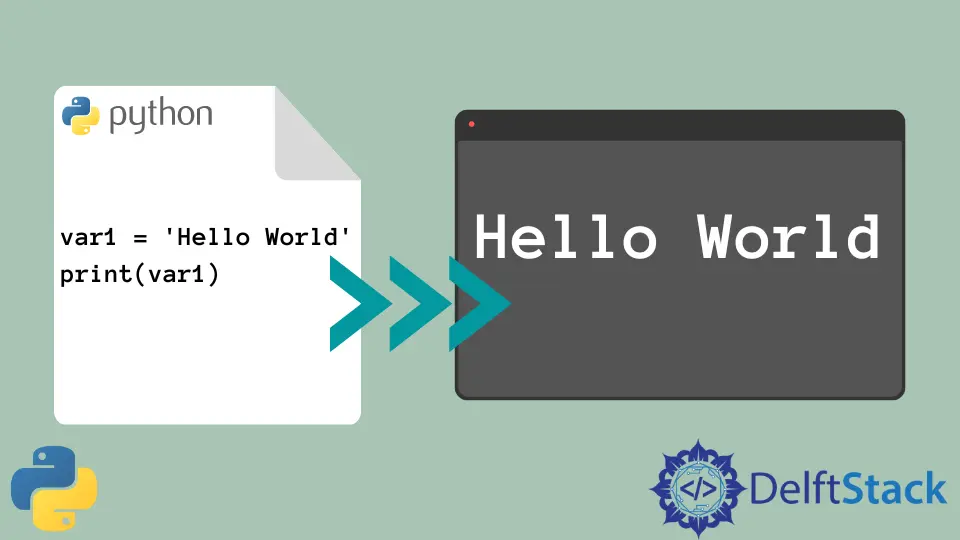Python 打印变量
-
在 Python 中使用
print语句来打印变量 -
使用逗号
,分隔变量并打印它们 -
在
%的帮助下使用字符串格式 -
在
{}的帮助下使用字符串格式 -
使用
+运算符在print语句中分隔变量 -
在
print语句中使用f-string

Python 是最通用的编程语言之一,并且 print 语句可以以多种不同方式使用。我们可以根据需要选择使用语句的方式。
本教程将讨论在 Python 中打印变量的不同方法。
在 Python 中使用 print 语句来打印变量
print 语句可以在所有 Python 版本中使用,但其语法会有所不同,具体取决于 Python 版本。
在 Python 2 中,print 语句的语法非常简单。我们要做的就是使用 print 关键字。
示例代码:
# Python 2 code
print "Hello to the World"
输出:
Hello to the World
在 Python 3 中,要运行 print 语句而没有任何错误,需要在括号后面加上 print 关键字。
示例代码:
# Python 3 code
print("Hello to the World")
输出:
Hello to the World
尽管 Python 2 可以在带括号的情况下运行 print 语句,但是如果语句中未使用括号,则 Python 3 会出错。
print 语句可用于打印变量,字符串和 Python 提供的其他数据类型。
通过使用 , 符号分隔数据类型或变量,我们可以在 Python 的单个语句中打印不同的数据类型。
我们将展示在 Python 中打印变量的不同方法。
使用逗号 , 分隔变量并打印它们
在 Python 中打印变量的最基本方法是使用逗号在 print 语句中分隔变量。
以下代码在 Python 代码的同一行中打印变量和字符串。
var1 = 123
var2 = "World"
print("Hello to the", var2, var1)
输出:
Hello to the World 123
在%的帮助下使用字符串格式
除了仅打印语句外,还可以使用字符串格式。这给用户提供了更多选项来定制类似字符串的设置,并调整填充,对齐,设置精度甚至宽度。
实现字符串格式的两种方法之一是使用%符号。%符号,后跟一个字母,用作变量的占位符。
例如,当我们需要替换数值时,%d 可以用作占位符。
示例代码:
var1 = 123
var2 = "World"
print("Hello to the %s %d " % (var2, var1))
输出:
Hello to the World 123
在 {} 的帮助下使用字符串格式
使用字符串格式时,我们可以使用 {} 标记语句中需要替换变量的位置。
以下代码通过使用字符串格式在 Python 代码的同一行中输出变量和字符串:
var1 = 123
var2 = "World"
print("Hello to the {} {}".format(var2, var1))
输出:
Hello to the World 123
format() 函数已添加到 Python 2.6 中,并且此后在所有其他版本中均可使用。
使用+ 运算符在 print 语句中分隔变量
在使用 print 语句时,也可以使用+ 运算符来分隔变量。
示例代码:
var1 = 123
var2 = "World"
print("Hello to the {} {}" + var2 + str(var1))
输出:
Hello to the World 123
在 print 语句中使用 f-string
f-string 是另一种实现字符串格式化的方法,它比其他两种方法具有优势,因为它比其他两种机制要快。
示例代码:
var1 = 123
var2 = "World"
print(f"Hello to the {var2} {var1}")
输出:
Hello to the World 123
如上所示,所有 5 种方法都提供相同的输出。而一个人应该使用的方法取决于他自己的便利。
Vaibhhav is an IT professional who has a strong-hold in Python programming and various projects under his belt. He has an eagerness to discover new things and is a quick learner.
LinkedIn